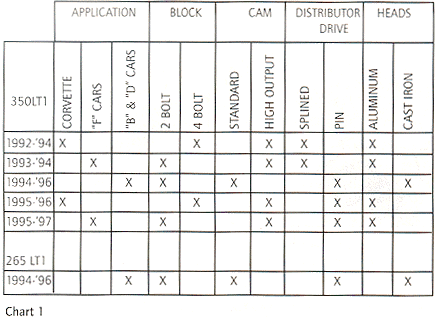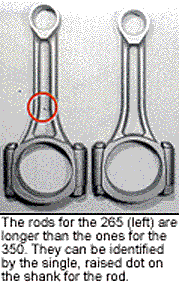
Compared to the 1991 Chevy 350 L98 with TPI, the LT1 made 20 percent more horsepower, got better fuel mileage, and had a much broader torque band with 90 percent of its peak torque available from just over 1,000 rpm all the way up to nearly 6,000 rpm.
GM Powertrain accomplished all of this by reverse cooling the engine so they could bump the compression ratio up to 10.5 to 1, tweaking the airflow in and out of the engine, and using sophisticated electronic controls for both fuel and ignition. This combination gave the LT1 300 hp in 1992 and ultimately led to the 1996 LT4 that used better heads, more cam timing, roller rockers and sequential fuel injection to make 330 hp.
Although the LT1 was only around for five years, there were two-bolt and four-bolt blocks, aluminum and cast iron heads, regular and H.O. cams that came with long and short dowels, and three different front covers. There was also the "Baby LT1," the 265 cid version that was the standard engine in the Caprice from 1994-‘96. With all that in mind, let’s take a look at this family of engines and see what goes where.
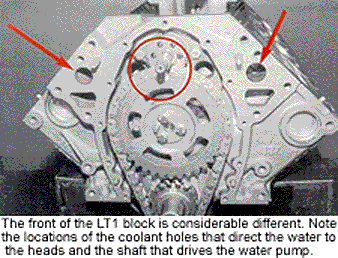
BLOCKS
350 – There are two blocks, one with two-bolt mains and one with four-bolt mains. They both have the same 10125327 casting number, so there’s no sure way to know which one you have until you get the pan off. However, if it came out of a Corvette, it should be a four-bolt block, and if it came out of anything else, it was supposed to be a two-bolt. GM used the two-bolt block for everything but the Corvette because it had plenty of strength and it weighed a little bit less.
265 – There was only one block used for the 265 cid version of the LT1. It’s a 10168588 casting that had the numbers "4.3" cast on the side, too. It’s real easy to spot if the heads are off because of the small 3.74" bore.
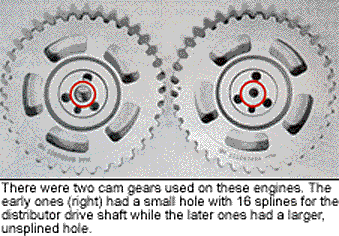
CRANKS
350 – The crank for the LT1 looks just like the one in the late 350 and has the same casting number, 14088526, but it’s balanced for the lightweight pistons that were installed in the LT1. Be sure to keep these cranks separate so they don’t end up in a regular 350, and don’t ever use a regular 350 crank in a LT1. In fact, if you are short of LT1 cranks and don’t have a balancing machine in your shop, you would be better off using a crank from a 305 instead of a 350 because it’s actually closer to the balance specs for the LT1 crank.
265 – The 265 has its own unique crank with a 3.00" stroke. That’s the same stroke the original 265 had back in 1955; it’s funny how things go around and come back full circle. It’s a 10168568 casting.
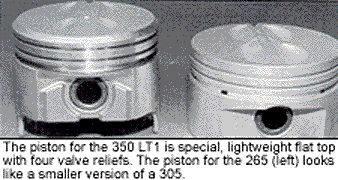
RODS
350 – The original LT1 came with regular forged 350 rods, that were shot peened for localized hardness under the head of the bolt and nut. Powdered metal rods were phased in for the Corvette around 1994 and used in all of the LT1 engines by 1995. GM made the change because the powdered metal rods were cheaper to make and were much stronger than the GM high performance "pink" rods. In fact, they are supposed to be good for up to 450 hp. They are machined at the parting line so they can be reconditioned.
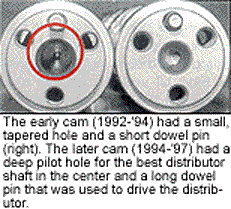
265 – The 265 rods are 0.240" longer than the ones in the 350. Both blocks are the same height, but the stroke for the 265 is 0.480" shorter, so the rods have to be longer to make up for half the difference. These rods can be identified by the single, raised dot on both sides of the shank. See photo to the right.
CAMS
Getting the right cam in the right engine can be a little bit tricky because there were several variations over the years. There are essentially two different grinds used with two different snouts, depending on which distributor was used on the engine.
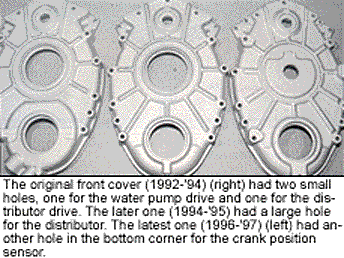
1992-’95 350 WITH ALUMINUM HEADS – The 1992 Corvette had a steel roller cam with a shallow hole in the snout that measured .450" in the front and tapered to .240" at the bottom. It had a short dowel (.320") that was used to locate the timing gear and a hole with 16 splines in the center for the stub shaft that drove the early distributor. The 1993-‘94 H.O. cam had a few changes, but all of the early H.O. cams are the same for all intents and purposes.
They can be identified by the number "241" stamped on the barrel in front of the first lobe.
1994-’96 350 WITH IRON HEADS – The distributor drive was changed on the iron-headed motors only in 1994, so the front of the cam and the timing gear were changed, too. The cam had a pilot hole that was bigger and deeper (0.500" x 1.0625"), and it had a longer (.685") dowel pin that stuck out beyond the timing gear to drive the new distributor. This iron-headed motor was used in the Chevy Caprice, Buick Roadmaster and Cadillac Fleetwood, so it came with a milder cam that improved low end torque and reduced valvetrain noise. These cams have the long dowel pin and either "600" or "779" stamped on the barrel of the cam in front of the first lobe.
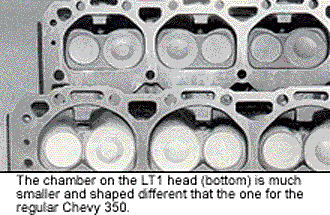
1995-’97 350 WITH ALUMINUM HEADS – In 1995, the aluminum-headed motors got the late, pin-drive distributor, so there’s a second version of the H.O. cam with the big pilot hole (.500" x 1.0625") and the long (.685") dowel pin. See the photo. Look for a cam with the long pin and either "242" or "705" stamped on the barrel in front of the first lobe.
1994-’96 265-INCH MOTORS – All of the 265 engines came with the later, pin-drive distributor, so they all had the later style cam with the big pilot hole and the long dowel pin. The 265 used the same mild cam that came in the iron-headed LT1. Look for the long dowel pin and either "600" or "779" stamped on the barrel of the cam in front of the first lobe. See photo.
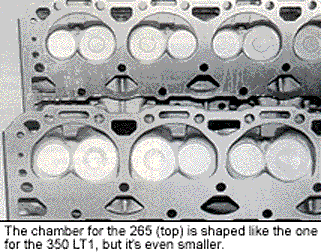
CAM GEARS
The cam gear had to match the cam and the distributor drive, so there were two different gears used, depending on the year and the application.
The original cam had a small, tapered hole in the center and a short dowel pin. It was used with the cam gear that had the small hole in the center with 16 splines in it. See the photo. It was connected to the distributor with a short drive shaft that was splined on both ends. The cam gear is a GM p/n 10128349. This combination was used from 1992-‘95 on the aluminum-headed motors.
GM had some problems with the early distributor due to both carbon tracking and moisture, so a new sealed distributor with a vacuum port was introduced on the iron-headed 265s and 350s in 1994 and used on all LT1s in 1995. The new distributor was located with a pilot shaft and driven by a pin, so both the cam and the gear were changed. The cam had a large, deep hole in the center for the pilot shaft and a longer dowel pin to drive the distributor.
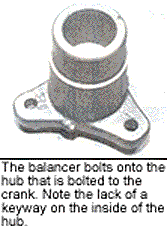
The cam gear had a bigger hole and it didn’t have the splines that were found in the early gear. See the photo. The pilot shaft for the distributor extends through the hole in the cam gear and seats in the hole in the cam; the distributor is driven by the long dowel pin that sticks up through the cam gear. The cam gear is a GM p/n 10206039.
FRONT COVERS
The front covers have been changed three times, once because of the changes that were made to the distributor and once due to OBD II. See the photo.
The original cover had three holes, one for the crank, a small hole (@ 0.70") for the water pump drive and a second one for the small drive shaft for the distributor. It’s a 10128289 casting.
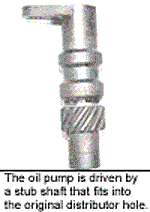
The second front cover still had the small hole for the water pump shaft, but it had a much larger hole (@ 2.63") that sealed on the outside of the distributor housing itself. It’s a 10214196 casting.
The second cover was modified again in 1996 to accommodate the crank position sensor that was located in the lower corner of the cover on the passenger side. This same cover was used for the few engines that were installed in 1997, too. It’s a 12550032 casting.
HEADS
There were two heads used on the 350, one aluminum and one cast iron, along with one cast iron head for the 265. GM claimed that the original LT1 aluminum head had a 15 percent increase in airflow as a result of revised port angles and higher port ceilings when compared to the 1991 L98 head. That was impressive in 1992, but the iron LT1 head that came out in 1994 was even better. It flowed 20 percent more on the intake side and made more horsepower on the dyno.
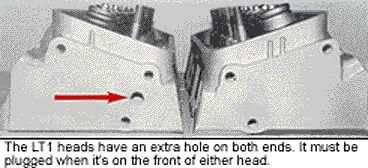
All LT1 heads used small combustion chambers to get the higher compression ratios with flat top pistons; the 350s had a 10.5 to 1ratio and the 265s had a 9.8 to 1 ratio. See the photo.
350 ALUMINUM HEADS – There were two versions of these heads used on Corvettes, Camaros and Firebirds. Later ones have less material around the top of the intake ports and weigh about 2-1/2 lbs. less than the earlier ones, but they are identical otherwise. Look for a 10128374 and possibly a 649.
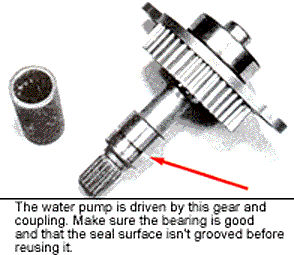
350 IRON HEADS – All of the full-size cars came with iron heads. They were 10125320 or 12554290 castings.
265 IRON HEADS – The 265 had its own unique cast iron head with a 10208890 casting number. The chambers are smaller, so these heads cannot be interchanged with any of the 350 LT1 heads. See the photo.
That’s the story on the parts for the LT1. Chart 1 at bottom shows how they all fit together year by year, but there are a few more things every rebuilder should know in order to avoid some possible problems.
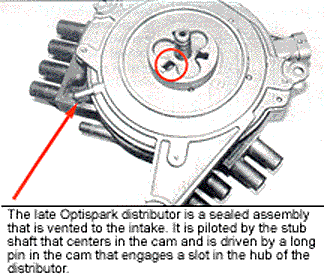
HEAD GASKETS
The 350 LT1 head gaskets are not interchangeable with regular 350 Chevy head gaskets because they have different water passages due to the reverse cooling.
The original head gaskets on the LT1 were wider and had holes that held the pushrods in place for assembly, but the replacement gaskets look a lot like the ones used on a regular 350. Make certain not to mix them up.
DISTRIBUTOR SHAFT
The drive shaft for the early style distributor is reversible by design, but it may have a machined lead on it that will cause it to pump oil past the front cover seal if it is installed backward. Unfortunately, the shop installs it, so all you can do is wait for the phone call when the seal leaks and they’re looking for someone to blame.
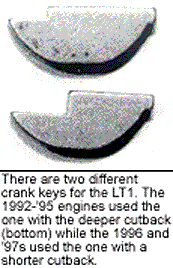
CRANK KEYS
There is no keyway in the hub for the harmonic balancer, so GM used a special cutback key that was flush with the front of the timing gear on the 1992-’95 engines. It’s p/n 10128303.
When the crank position sensor was added in 1996 for OBD II, the cutback area on the key was shortened so it stuck out far enough (about 0.100") beyond the face of the timing gear to index the notched disc that was used for the crank position sensor. See photo.
Use the correct key for the year of the engine. Don’t try to get by with a regular 350 key; the hub will hit it before it bottoms on the crank gear and it will cause the balancer and belts to be misaligned.
EXTERNAL COOLANT LINES
There is an extra hole that goes into the water jacket on both ends of the heads. See the photo. These should be plugged when they’re in the front but left open when they’re on the back. There’ s an external coolant transfer line that connects the holes on the back side to a reservoir that vents the air and steam vapors that would be trapped in the head and cause hot spots. See the photo.
FRONT TAPPET CUP PLUGS
Both of the cup plugs in the front of the lifter galleries have a 0.030" hole drilled in them. These prevent air pockets from forming in the front of the galleries and provide added lubrication to the water pump gear drive.
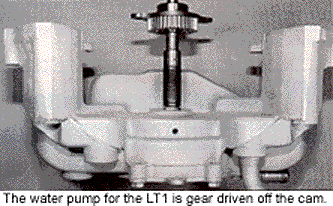
WATER PUMP DRIVE SHAFT
Be sure to check the seal surface on the geared shaft that drives the water pump. If it’s grooved, it will leak and it will be your fault. See the photo. New ones are available from GM (p/n 10219554) for around $40. That’s cheap insurance when you consider that the timing cover, chain and gears have to come off to replace it.
OIL PUMP
The LT1 powerplant uses the late model 350 oil pump with the 3/4" pickup tube. This should be fairly easy to identify.
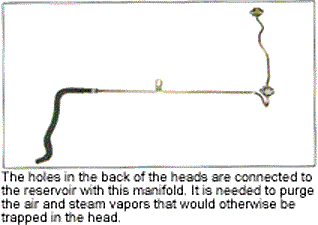
HUB AND BALANCER
The balancer is a two-piece assembly with a pulley that bolts onto the hub. Separating the two made it easier to install the Optispark distributor on the assembly line and out in the field. See the photo. The holes in the hub are offset, so the balancer only fits on it one way, but there’s no keyway in the hub to index the hub on the crank. This shouldn’t be a problem unless the damper was drilled at the factory to "trim" the final engine assembly.
If it was drilled a lot to compensate for an engine that was out of balance, you could end up with a shaker, depending on how everything stacked up with the remanufactured engine compared to the original engine. If you encounter a balance problem on a remanufactured LT1, try rotating the balancer assembly on the crank 90° at a time to see if it eliminates the problem.
THE LT4 CHEVY
There is one more version of the LT1 out there that could cause some confusion if you get a core and don’t know what it is. The LT4 was the high performance version of the LT1 that was standard in the 1996 Corvette "Grand Sport" and optional for any 1996 Corvette with a manual transmission. There were also 100 1997 SS Camaros built by SLP that came with the LT4. Chances are most rebuilders will never see one, but just in case you do, the following are a few things that make the LT4 special.
BLOCK – Should be the same LT1 casting with the four bolt mains.
CRANK – The LT4 has a special nodular iron crank with undercut and rolled fillets for added strength.
RODS – Powdered metal rods are used with a "cracked cap" instead of a machined parting line.
CAM – The LT4 cam was similar to the ones used in the high performance LT1, but it has had considerably more lift at the valve because it had 1.6 to 1 rockers.
HEADS – The heads had smaller, 54cc chambers that gave the LT4 a 10.8 to 1 compression ratio. The intake ports were raised 0.100", too. The LT4 used larger intake and exhaust valves (2.00" x 1.55"). The intake stems were hollow to reduce weight and the exhaust stem was sodium-filled to improve heat transfer. The valve springs were made of oval wire to prevent coil bind with the higher valve lift and fitted with lightweight retainers to help the engine rev to its 6,300 rpm redline.
All of these changes enabled the LT4 to make 330 hp at 5,800 rpm instead of 300 hp at 5,000 rpm. That’s about all you need to know about the LT1 family. They’re out there and they’re old enough to show up on your dock.
